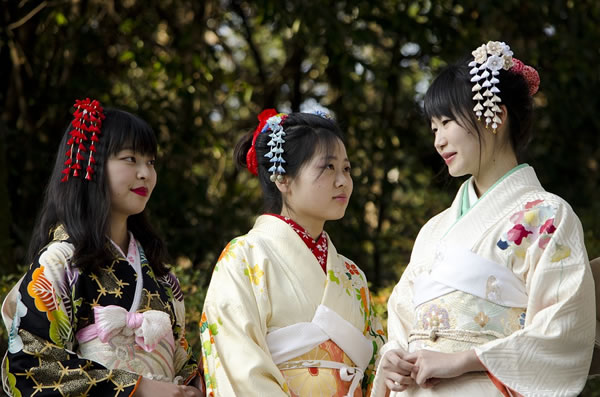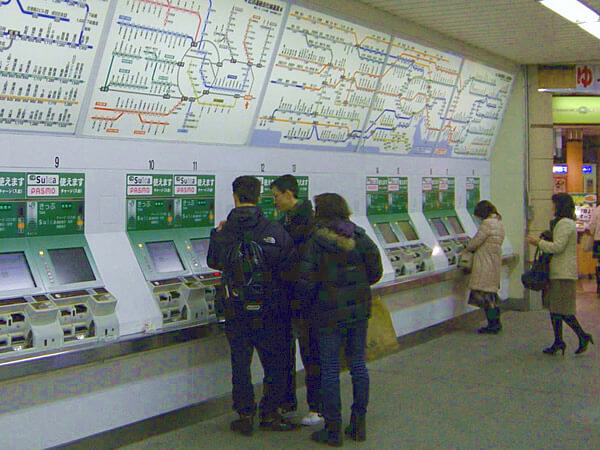Feeling Welcome in Japan
By Nancy Penrose

|
|
Feeling a sense of welcome from the locals in Japan.
|
Preparation
When my husband scheduled a weeklong business trip to the Tokyo area, I leapt at the chance to go along and make use of his paid-for hotel room. I had concerns though: Would I be able to find my way around, not speaking or reading Japanese? I wondered how much English signage there would be in the excellent train and subway systems. And I wondered what would happen when I got out of a station and onto a street? I have a poor sense of direction and can easily get turned around even with a map. Would I feel welcome, a 6-foot, red-haired, middle-aged Western woman on her own in Tokyo? I’ve been traveling or living in foreign countries since I was four years old, and I have experienced the spectrum of reactions: from curiosity to hostility, from aggressiveness to kindness, from disdain to welcome. What would I find in the Japan?
At home in Seattle, I began to prepare. I read guidebooks and websites. I learned a few essential words from a phrasebook with a CD. In a book aimed at expatriates living in Tokyo, I was reminded that Japanese culture particularly values harmony and proper behavior within the group. I hoped to become a good, if temporary, member of the group.
Arrival
My first step after clearing customs at Narita was to find the Japan Rail (JR) office where I could buy a Suica card. This stored-value card is good on the mix of train and subway lines in the greater Tokyo area and eliminates having to figure out how much to pay for each trip: the proper amount is automatically debited when the card is swiped as you exit the station.
Guidance in Japan
Entering the JR office, I encountered my first guidance as to how to behave in Japan. A young woman immediately approached me and asked, “How may I help you?” I explained my needs. Then, with a commanding sweep of her hand, palm up, and a polite but firm “Please,” she indicated lines painted on the floor, the path leading to the Suica card counter.
I encountered this gesture often, guidance for where to stand to eat after buying a snack from a kiosk on the street, to which seat to take in a restaurant. I found yet more guidance stenciled onto street corners and posted on trains and in stations: where to stand while waiting for the walk light to change, where to line up for Car#5 of the bullet train, signs reminding riders not to talk on mobile phones in subway cars. I welcomed these tips on how to behave properly.
Transportation, Adaptation, and Signage in Japan
By the morning of my first trip into Tokyo from our hotel in the Chiba suburbs, I had already spent a bit of time exploring the nearby train station that I would use for the 30-minute train ride into the city. I had noted many signs that included English and had figured out how to find the platforms for the trains to Tokyo. I swiped my Suica card, it peeped-peeped properly, and the ticket gate slid open. A train pulled in and I settled into place. I looked around and noticed that my fellow travelers, all Japanese, were each taking up only one space, even if there were empty seats next to them. Their belongings were at their feet or held on their lap. Suddenly aware of my American tendency to sprawl out over two or three seats when there is room, I shifted my backpack onto my lap and tucked in the hem of my coat that was spread out wide on either side of me.
On that first trip, I discovered that English signage was plentiful: on the system maps above the doors of the train and subway cars and on the platform signs that named the stations we passed through. In the Tokyo stations I found abundant signage either in English or international symbols that helped me find women’s toilets (often with a symbol for western-style commodes on stall doors), elevators, escalators, exits labeled by neighborhood, and directions to connections for the numerous subway lines.

|
|
Train station near Chiba. Photos by Nancy Penrose.
|
Once outside, street signs were rare and postal addresses unhelpful. Building names, however, served as useful navigation tools and were often listed on maps. Occasionally there were neighborhood “You Are Here” maps in both English and Japanese posted near sidewalks in the more touristed areas such as the Ginza shopping district.
The next day, on my second trip into the city, I was running a bit late for an 11 a.m. National Theatre show of bunraku, the elegant performance art using Japanese puppets. Arriving at Tokyo station, I took the JR Yamanote Line one stop to the JR Yurakucho station where I thought I would find platforms for the Yurakucho subway line I needed to get to the Theatre. What I didn’t know is that there are two stations with the same name, but serving different train and subway lines. I scanned all the signs several times until I finally found one outside the JR station that pointed me to the basement of a shopping complex and through long corridors, but indeed eventually to the line I needed.
Exiting the station at my destination, feeling rushed because it was now 10:45 a.m., I knew this was the kind of situation where I could easily get turned around. I approached a professionally dressed Japanese woman and said in an humble voice, “Sumimasen,” Excuse me, “Kokuritsu gekijo?, my voice rising in a question. No doubt I mangled the Japanese words for National Theatre, but I pointed to the map in my brochure from the Tourist Office where the name was written in Japanese characters. The woman willingly stopped, studied the map intently, and then with a bit of English and arm waving, pointed out which way to go. She watched as I rushed off, then vigorously gestured left when I reached the first cross street. I made the performance.
People Watching in Japan
I am a people watcher, a trait magnified when I travel. On the train to and from Tokyo, I enjoyed indulging: an older woman in a kimono, salarymen in dark business suits, a child quietly reading a book, a teenage girl checking her makeup by using the camera on her cell phone like a mirror. I realized, though, that my fellow riders who were Japanese rarely looked up and around or used their eyes to interact with other people. This puzzled me at first. To my American mind such interaction has the quality of mutual acknowledgement. But then I remembered reading that the Japanese rarely maintain direct eye contact. Perhaps my people watching seemed rude and intrusive. I tried to be more subtle.
Community and Helpfulness
I had also read how the Japanese feel connected to each other as a group by a sense of interdependency and responsibility. Even though, as a Caucasian Westerner, I was obviously an outsider, I often benefited from being a temporary member of the group. Once, sitting at a long stop of a local train, I watched as several people got up and left the car when a faster train to their destination pulled into the station. It was cold outside and every person made sure to press the “CLOSE” button as they exited the train doors to help keep out the cold air for the group left onboard.
I always feel a bit embarrassed at having the unearned good fortune of being a native speaker of the language that has become the lingua franca of world travelers. In Japan I was grateful for the many kind strangers who were willing to use their English to help me. And in a country where the Roman alphabet is not used in the local language, the abundant English signage was obviously aimed at helping travelers.
For the most part on this trip, I found that I was left alone until I asked for help. I sensed little curiosity or interest in interacting with me, and certainly no hostility. When I entered a restaurant or shop, I felt I was treated as a local resident would be. Irasshaimase! Welcome! is the greeting often shouted out heartily by the staff when customers enter restaurants or stores. Irasshaimase describes how I felt as a Western traveler in Tokyo.
|
For More Information
on Japan
My first stop in Tokyo: Japan National Tourist Organization office at Yurakucho: walking distance from Tokyo Station and near the two Yurakucho stations, on the 10th floor of the Kotsu Kaikan building, which has the name posted on the outside.
Suica Cards offer no discounts, but huge convenience. They are available many places and are easily refilled at machines in Tokyo-area train and subway stations.
Online information on the Tokyo area metro lines.
See Transitions Abroad's Articles and Resources on Japan for more information and perspectives on the fascinating country.
|
Nancy Penrose lives in Seattle. She is a lifelong traveler who writes to explore the territories where cultures converge.
|
